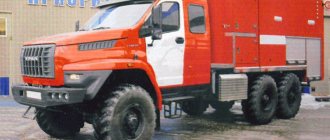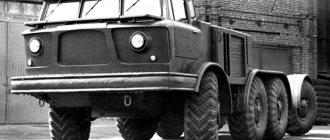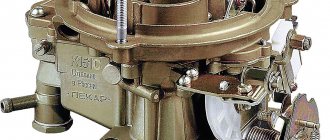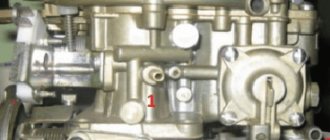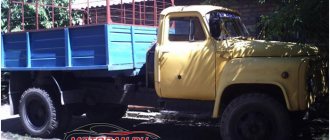The UMZ 421 engine is based on the design solutions of the previous 417 series and the GAZ 21 engine. The prototype, labeled 4218.10, was completed in 1983, but it was refined for another three years. After which, the designers worked on version 241.10 with the original shape of the exhaust tract.
ICE UMZ 421
Then 8 more modifications were added with increased power, compression ratio, deformed, with a different camshaft, complying with Euro-4 standards and two gas-gasoline options. As a result, the 421 ICE line is produced to this day; it is equipped with cargo and passenger Gazelles, Sobols, Barguzins and Hunter SUVs, and cargo-passenger UAZ “Loaves”.
Technical characteristics of UMZ 421 2.9 l/98 – 125 l. With.
Initially, in the engine of the first version 4218.10, antifreeze penetrated through the pores of the aluminum casting of the cylinder block into the oil. The leak was irreparable, replacing the cylinder head gasket did not help, so the manufacturer impregnated the block with resin using aircraft manufacturing technology, changed the shape of the intake tract, and named the engine 421.10.
Modified version 421.10
To increase low-end torque and overall power, the engine circuit received two additions:
- a resonator in the exhaust system located after the muffler;
- increasing the compression ratio.
Exhaust system resonator
This version of the internal combustion engine is designated 421.10-30 and has its own repair manual. The engines left the factory with 100 mm cylinders, which initially provided high torque and power. The manual of the automaker GAZ recommends them for installation on the Gazelle, which requires minor modifications:
- the Gazelle radiator is located lower than in UAZs;
- the fan needs to be moved;
- a drive with a separate belt appears.
ICE for Gazelle
The power supply system and gas removal from the crankcase have been additionally improved; the motor is designated 4215.10-30. If the oil consumption of the 421 family models is the same, then different fuels can be used.
To reduce the operating budget of a truck and minibus, the GAZ manufacturer switched many Gazelles and Sobols to A-76 gasoline. A similar modification of the UMZ engine for low-octane gasoline was designated 4215.10-10.
Then an injection version was required, but for all-wheel drive UAZs - minibuses, SUVs, trucks and utility vehicles. This was the 4213.10 engine. The camshaft here is cast iron, not steel, as in carburetor engines. For Gazelles, such an internal combustion engine was 4216.10 with a modified fan drive.
UMZ 421 injector
This series 421 was the last from the UMP manufacturer with a lower camshaft. Already for the next generation of 429.10 high-speed internal combustion engines, the camshaft was moved inside the cylinder head, that is, located on top.
The table contains the main technical characteristics of the UMZ 421 motor:
| Manufacturer | UMP |
| Engine brand | 421 |
| Years of production | 1993 – … |
| Volume | 2890 cm3 (2.9 l) |
| Power | 72 – 92 kW (91 – 125 hp) |
| Torque moment | 220 Nm (at 4200 rpm) |
| Weight | 170 kg |
| Compression ratio | 8,2 (7) |
| Nutrition | carburetor/injector |
| Motor type | in-line petrol |
| Ignition | switching, contactless |
| Number of cylinders | 4 |
| Location of the first cylinder | TVE |
| Number of valves on each cylinder | 2 |
| Cylinder head material | aluminum alloy |
| Intake manifold | duralumin |
| An exhaust manifold | combined with resonator and exhaust pipe |
| Camshaft | lower, OHV circuit |
| Cylinder block material | resin impregnated aluminum alloy |
| Cylinder diameter | 100 mm |
| Pistons | the groove in the form of a truncated cone is part of the combustion chamber |
| Crankshaft | steel, then cast iron |
| Piston stroke | 92 mm |
| Fuel | AI-92/A-76 |
| Environmental standards | Euro-0 (Euro-4) |
| Fuel consumption | highway – 8.8 l/100 km combined cycle 11 l/100 km city – 12.5 l/100 km |
| Oil consumption | maximum 0.3 l/1000 km |
| What kind of oil to pour into the engine by viscosity | 15W40, 5W40, 10W30, 10W40, 20W40 |
| Which engine oil is best by manufacturer | Liqui Moly, LukOil, Rosneft |
| Oil for UMZ 421 by composition | synthetic in winter, semi-synthetic in summer |
| Engine oil volume | 6 l |
| Operating temperature | 90° |
| ICE resource | declared 250,000 km actual 350,000 km |
| Adjustment of valves | nuts |
| Cooling system | forced, antifreeze |
| Coolant volume | 10.7 l |
| water pump | with plastic impeller |
| Spark plugs for UMZ 421 | Czech Brisk DR17YC/A |
| Spark plug gap | 0.8 mm |
| Timing drive | gear |
| Cylinder operating order | 1-3-4-2 |
| Air filter | Nitto, Knecht, Fram, WIX, Hengst |
| Oil filter | removable with non-return valve full-turn |
| Flywheel | with clutch landing diameter 200 mm or 215 mm |
| Flywheel mounting bolts | M12x1.25 mm, length 26 mm |
| Compression | from 10 bar, difference in adjacent cylinders maximum 1 bar |
| XX speed | 800 min-1 |
| Tightening force of threaded connections | spark plug – 60 Nm flywheel – 70 – 88 Nm clutch bolt – 60 Nm bearing cap – 120 Nm (main) and 60 Nm (rod) cylinder head – three stages 42 Nm, 106 Nm + 90° |
The table provides a description of the parameters of the basic carburetor version 4218.10. Other engines use different attachments, the layout of the exhaust and intake tracts, and the injection systems have been changed.
Operational properties of UMZ-4218 power plants
The motor in question is a complex set of four cylinders alternately located on the same line, each of which is equipped with two valves. The engine uses a carburetor supply of the fuel mixture. Less commonly, the power system is represented by an injector.
The 92 mm piston performs its functions in the middle of a cylinder with a cross section of 100 mm. The capacity of the internal working space of 2,890 liters allows the car to compete in agility with 98 horses, while performing 4000 revolutions.
An attractive feature is the possibility of using gasoline available at a price of 92 to refuel the unit. Although this pushed the engine back to Euro-4 parameters. This fact does not stop domestic motorists, since they are not used to monitoring environmental standards while constantly fighting off-road conditions.
In addition, fuel consumption is also considered acceptable, amounting to 11 liters for the combined cycle, which is negligible for the significant weight of the machine.
If the manufacturer provides for filling a pristine engine with 5.8 liters of lubricant, then when changing the oil you can get by with five liters. Of course, it is recommended to take into account the seasonality of the petroleum product and follow the manufacturer’s instructions when choosing.
UMZ specialists assure buyers that a car with unit 4218 is capable of covering 250 thousand km without major repairs. To the delight of the owners, the practical indicators of the motor’s service life exceed those declared by the manufacturer. As noted above, this is achieved through improvements to the cylinder block.
Design Features
Since the UMZ 421 engine evolved from the basic versions of the UMZ 417 and ZMZ 402, and even earlier - the GAZ 21, the design differences are:
- For the first time, this manufacturer used dry liners inside the cylinder block;
- the piston pin is shifted upward by 7 mm;
- rubber seal for the rear crankshaft support instead of stuffing with cord;
- the forces on the side surfaces of the piston are reduced due to an increase in the length of the connecting rod by 7 mm;
Cooling system
To carry out major repairs on your own, garage conditions and ordinary tools without special devices are enough.
Characteristics of the UAZ 469 engine
The UAZ 469 has a 4-cylinder engine of the UMZ 417 series with a volume of 2.5 liters. The power of such an engine reaches 75 horses, the valves are located at the top. The fuel supply system is forced. Closed cooling system, liquid with forced circulation. The nuance of this engine is quite decent fuel consumption, up to 16 liters per hundred.
Two different modifications of this engine are installed on the UAZ 469 for two different purposes. UMZ 4178 - for ordinary civilian models, UMZ 4179 - for military ones. The difference between “military” motors is that they are equipped with a distribution sensor and high-voltage shielded wiring. In addition, they have a special place for heating.
A distinctive feature of the UMZ 417 series engine is the special design of the combined cylinder block and the upper part of the crankcase into a single unit, made of high-strength aluminum alloy. The cylinders are wet removable liners and are cast from gray cast iron. The wear resistance of the liner is ensured by acid-resistant cast iron in the upper part.
Aluminum cylinder head assembly for UMZ 417 engine
The cylinder head is common to all cylinders and is made of aluminum alloy, just like the pistons. The five-bearing crankshaft is made of magnesium cast iron.
List of internal combustion engine modifications
Traditionally, for the Ulyanovsk Motor Plant, management develops motors in series. The main engine was 4218.10 with Euro-1 characteristics, power 98 hp. s., compression ratio 7 units. The UMZ 421 engine family includes several modifications:
- 4218.10-10 – carburetor, to adapt to AI-92 gasoline, the compression ratio is increased to 8.2, power is increased to 103 hp. With.;
- 421.10 – carburetor, new exhaust tract design;
- 421.10-30 – carburetor, exhaust manifold of a different design;
- 4213.10-40 – injector for UAZ, Euro-3, power 117 hp. With.;
- 4213.10-50 – injector for UAZ, Euro-4;
- 4215.10-10 – carburetor for A-76;
- 4215.10-30 – carburetor, for AI-92;
- 4216.10 – injection, for AI-92 for Gazelles, Euro-3, compression ratio 8.8, power 123 hp. With.;
- 42164.10 – injector for Gazelle, power 99 l. With.;
- 42164.10 – injection, for Gazelle, Euro-4, power 125 hp. p., new camshaft;
- 421647.10 – gas-gasoline version with a capacity of 100 hp. With.;
- 42167.10 – gas-gasoline version with a capacity of 123 hp. With.
UMZ 4213.10
UMZ 4215.10
UMZ 4216.10
Gasoline UMZ 421647.10
A distinctive feature of the 421 motor family is the availability of the 4219 variant for military equipment. Depending on what attachments are used in the internal combustion engine configuration, there are several options for 4219.10:
- 4179.10-01 – for a 254 mm lever type clutch;
- 4179.10-13 – power steering added;
- 4179.10-05 – for diaphragm clutch with a diameter of 240 mm;
- 4179.10-25 – power steering pump added.
Military version 4219.10
The motors have the same volumes; the goal here was not to increase power. A nuance is the presence of a starting heater, a G-250 generator, a fine gasoline filter and shielding of the R-132 sensor and high-voltage equipment ordered by the RF Ministry of Defense.
Characteristics, types and applicability of UMZ-4218 engines
In the early 90s, the Ulyanovsk Automobile Plant began to feel an acute shortage of powerful and reliable engines that could provide new UAZ vehicles with better speed characteristics and cross-country ability. By 1993, based on the UMZ-4178 unit, a new UMZ-4218.10 engine was developed and put into production, which was distinguished by its large volume and torque for passenger cars. However, this unit had a number of “childhood diseases” that were “cured” with the subsequent modification - UMZ-421.10. Subsequently, on the basis of the new engine, a whole family of power units was created, which today are used in UAZ and GAZelle vehicles.
Over time, the UMZ-4218 unit was improved, so today it is still in production and is actively used on various models of UAZ vehicles. Most often, the engine was (and is) installed on the UAZ-2206 (“Loaf”), 3306 (“Tadpole”) and the UAZ “Hunter” family.
UMZ-4218 is a gasoline four-cylinder in-line carburetor engine with a displacement of 2.89 liters and power from 84 to 112 hp. This difference in power is due to the characteristics of engines of different years of production - the early ones had less power. In addition, the power depends on the brand of gasoline used. Accordingly, the motors also have unequal maximum torque, which at 2000-2500 rpm can range from 189-221 Nm, in modern versions - up to 209 Nm.
Currently, UMZ-4218 engines are produced in three modifications:
- 4218.1000402-10 - for installing a lever clutch (with peripheral coil springs);
- 4218.1000402-30 - for installation of a diaphragm clutch;
- 4218.1000450-10 - for installation of a lever clutch without attachments.
Structurally, the engines are absolutely identical, the only differences being the flywheel and clutch housing. Naturally, the characteristics of the motors are also the same.
Advantages and disadvantages
Traditionally, for any family of engines, the weakest is the basic version, in this case, 4218.10. The disadvantages of the motor are:
- low quality metalworking;
- leaks of coolant, oil from the block, cylinder head and mixing of working fluids;
- outdated timing and drive circuit;
- increased consumption of fuel and lubricants;
- adjusting the thermal clearance of the valves every 15,000 miles.
On the other hand, the motor has many more advantages:
- factory tuning by boring cylinders up to 100 mm to increase performance;
- modernization of the exhaust stroke by combining the exhaust pipe, exhaust manifold and resonator into a single unit;
- the ability to make major repairs yourself;
- forcing the intake tract to increase power;
- a normal rubber seal instead of stuffing with a cord on the rear crankshaft support;
- service life from 250,000 km.
Intake manifold
For example, the designers used the cylinder head from the 417 internal combustion engine model, and the combustion chamber was enlarged due to the design of the piston, in which a cone-shaped recess was milled.
List of car models in which it was installed
Until 2005, most of the internal combustion engines of the Ulyanovsk Motor Plant were used by several car manufacturers. The UMZ 421 engine, which equipped the vehicles, was no exception:
- SUVs UAZ Hunter, Patriot, Bars, 3160,3161;
- all-terrain vehicle Simbir 3162, Tiger 2330;
- Pickup trucks, Cargo, 39095;
- minibuses 2206, 3303, 3741, 3909, 3962, Simba 3165;
- onboard Gazelle 3302;
- cargo-passenger Gazelle Farmer 33023;
- frame vans GAZ 2705;
- minibuses Gazelle 3221;
- vans and minibuses Sobol 2217;
- minivans Barguzin 2217.
Bus GAZ Simba
For two plants, the engine characteristics were ideal, but for the Gazelles the radiator and fan had to be moved in height.
Engine ignition installation
An ignition device used in a power plant, a product without which the operation of the engine is impossible. The correct operation of the engine and the combustion of the fuel charge are directly related to how to install the ignition on the UAZ 421 engine. Since hydraulic valve compensators are not structurally provided, manual adjustment is carried out, providing:
- Installation of the shaft in accordance with the advance angle of five degrees. Align the middle marking of the friction wheel with the influx of the core plug on the compression in chamber “1”;
- Find out the compression stroke of the chamber “1” by removing the plug. In this case, the slider is located against the inner contact surface of the plug, connected by a conductor to the spark plug of chamber “1”. An alternative definition based on the candle in chamber “1” involves dismantling the product. The resulting void is closed with a paper plug, and then the shaft is turned. On the compression stroke, the plug will come out of the hole;
- Using the “tenth” key, slightly unscrew the octane regulator;
- Set the octane regulator calibration to “0”, corresponding to the middle of the calibration;
- Using the “tenth” key, slightly release the octane regulator plates;
- Align the rotor mark (red marker) with the stator arrow by turning the distribution sensor frame. Fix the location by tightening the fasteners;
- Check the position of the slider (against the contact of the plug of the 1st chamber), check the correct connection of the conductors leading to the chambers. The countdown starts from camera “1”, counterclockwise, in the order “1st, 2nd, 4th, 3rd”.
The ignition operation must be additionally monitored while driving the vehicle. Briefly press the foot speed lever to full speed, having previously accelerated the car to a speed of 60 kilometers per hour. Detonation for 1-3 seconds indicates that the settings are correct. Longer - the advance angle is exceeded, no detonation - the advance angle is insufficient. In the last two cases, the setting is repeated.
Maintenance schedule UMZ 421 2.9 l/98 – 125 l. With.
The UMZ 421 engine can achieve a declared mileage of 250 thousand km only if the terms for replacing consumables and parts are met:
- 10,000 km – removable oil filter and engine oil;
- 15,000 mileage – valve clearance adjustment;
- 20,000 km – exhaust manifold assembly, fuel line and ramp, attachment belt and battery, spark plugs;
- 30,000 mileage – air filter and crankcase ventilation;
- 40,000 km – antifreeze and fuel filter;
- 60,000 mileage - oxygen sensor.
The internal structure of the internal combustion engine provides for these periods between overhauls, regardless of their number. This regulation is not suitable for gas-gasoline engines; they require replacement more often.
Valve adjustment 421 UAZ engine
Since the engine does not technically provide for the installation of hydraulic valve compensators, it is necessary to adjust the gap in the gas distribution mechanism through the established gap on the unit. The minimum distance traveled before adjusting the valves is 5000 km. If malfunctions in the operation of the motor are detected, the procedure must be carried out earlier.
Signs of incorrect valve adjustment settings:
- Reduced power of the power plant;
- The operation of the engine is accompanied by the knocking of valves;
- The appearance of flashes inside the carburetor in modifications where the product is provided;
- Popping sounds from the engine muffler.
The process of adjusting the valve clearances is accompanied by a parallel adjustment of the clearance in the rocker arms.
In addition, after the work is completed, the ignition of the unit is adjusted. The gap parameters are as follows:
- 0.3-0.35mm – valve clearances in cylinders 1 and 4;
- 0.35-0.4mm – valve clearances in cylinders 2 and 3.
Review of faults and methods for repairing them
Thanks to the grooves in the pistons, the UMZ 421 engine does not bend the valve with its pistons. Its individual faults are considered:
| Coolant getting into the cylinders and lubricant | irreparable defect, present only in the first batches of motors |
| Jumps in idle speed and power | Regular adjustment of valve clearances is required |
| Knocking sound in crankshaft bearings | replacement of worn-out liners |
The problems with the thermostat have disappeared, since the three-way version from Volga is used here. The viscous coupling, designed to regulate the speed of rotation of the impeller, often fails.
Repair of UMZ 421
Engine tuning options
Since the UMZ 421 family engine is designed for heavy trucks, minivans, off-road and all-terrain vehicles, utility vehicles, atmospheric tuning by mechanical means does not even make sense to consider. But it is quite possible to install an urban quiet type turbine. To do this you need to follow these steps:
- replacement of standard injectors with 440CC modifications from the manufacturer Subaru;
- modification of the intake manifold to integrate an intercooler;
- grinding of combustion chambers and channels inside the cylinder head;
- ShPG and shafts remain standard;
- Instead of a combined exhaust tract, a direct-flow spider 63 mm in diameter is mounted.
Turbocharger for UMZ 421
After flashing and tuning, tuning can add 30 - 50 hp. sec., the engine becomes “tractor-like” and has powerful torque in the lower speed range.
Thus, the 4218.10 motor with a very average resource due to defects in the casting of the cylinder block is considered to be the base motor in the series of the manufacturer UMP. But in all subsequent versions, not only this defect was corrected, but also other design solutions were used to improve performance and service life.
If you have any questions, leave them in the comments below the article. We or our visitors will be happy to answer them

